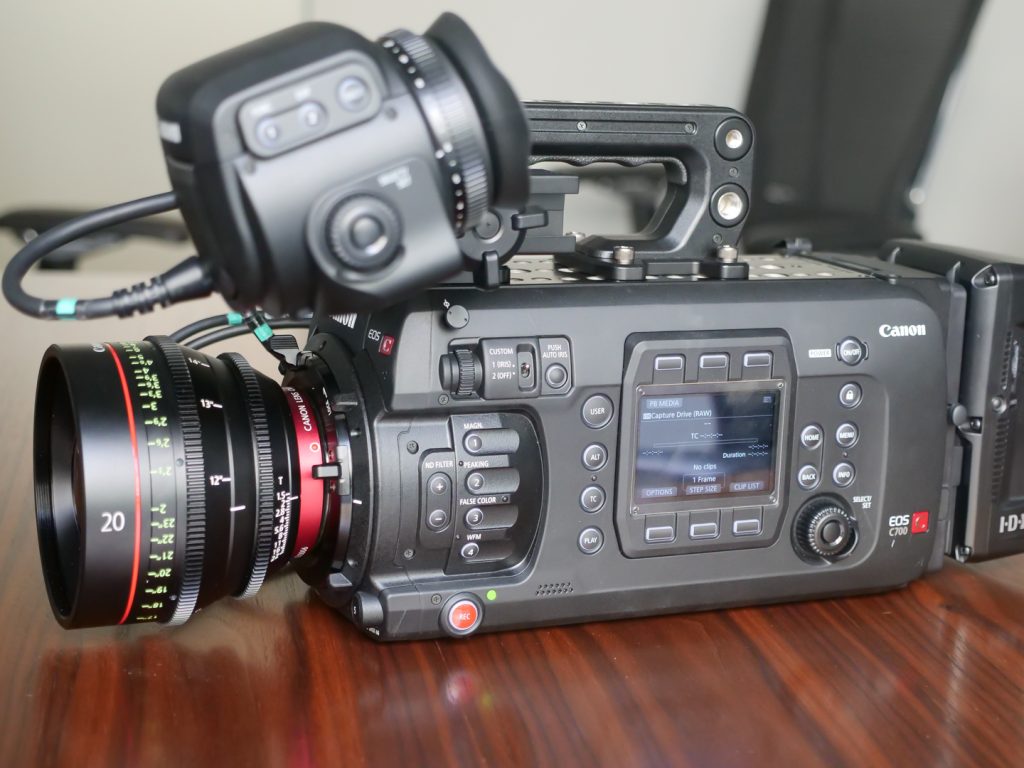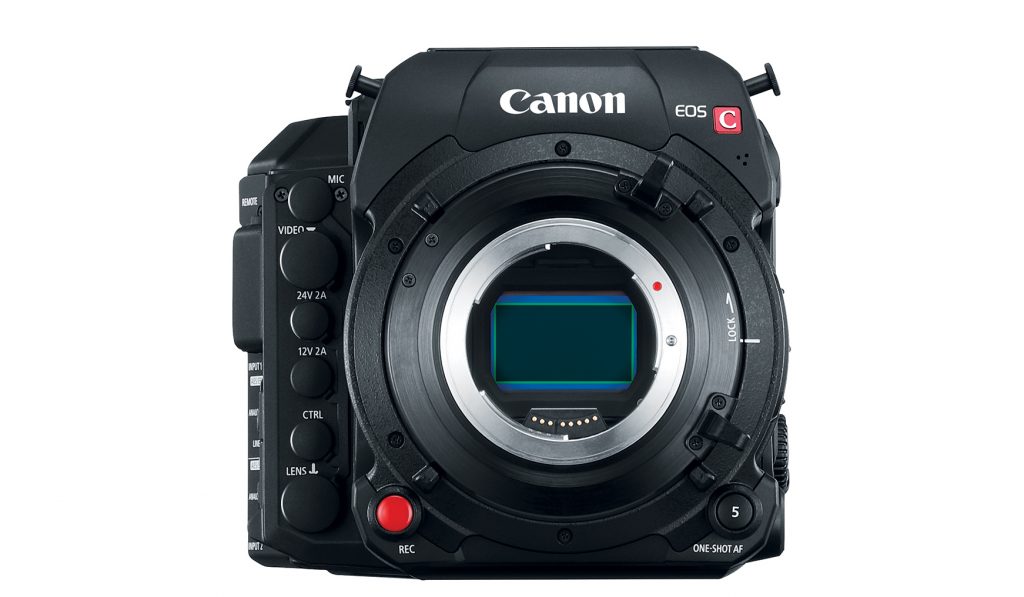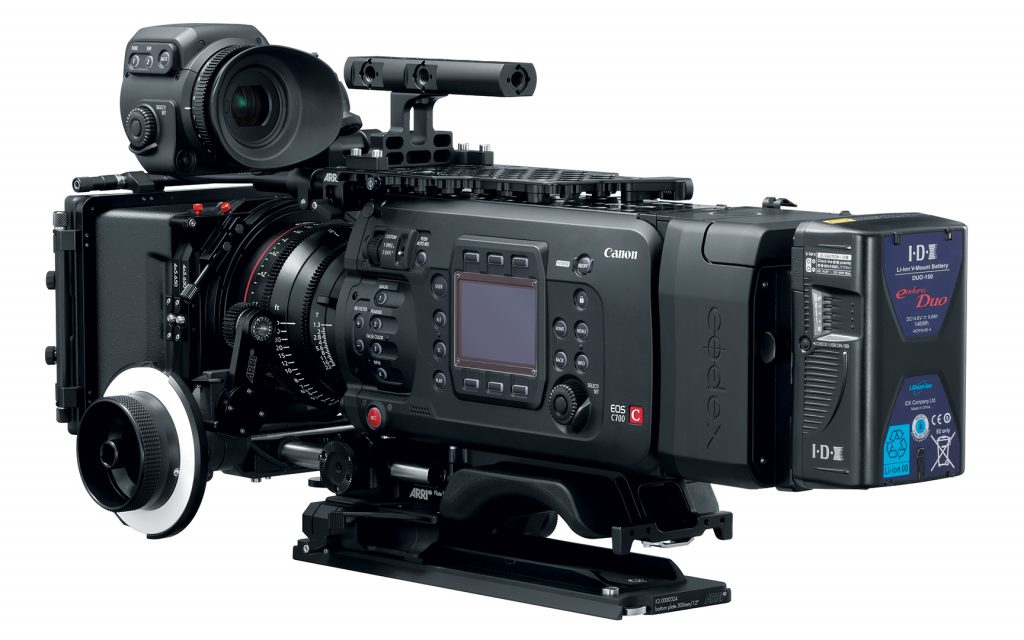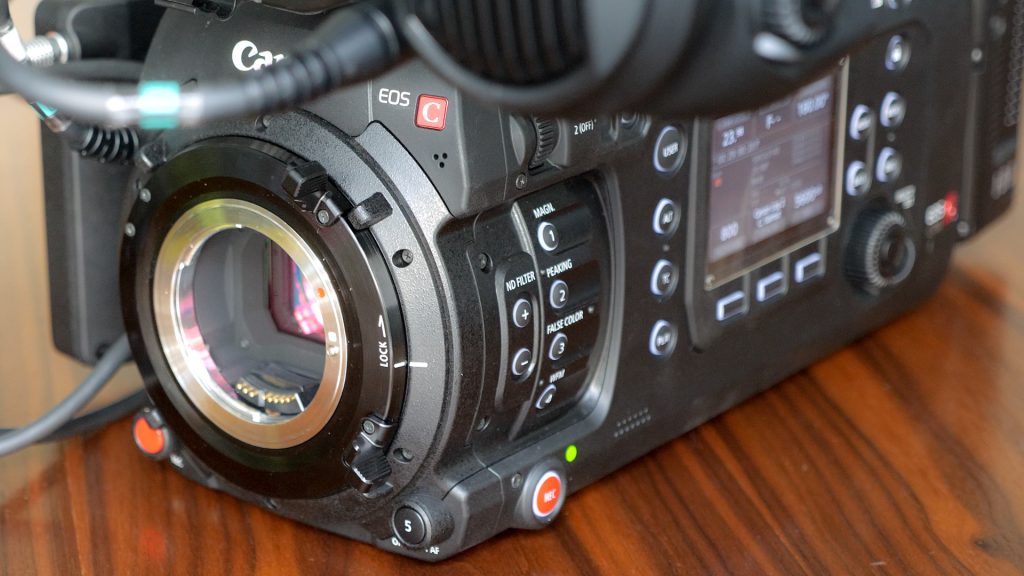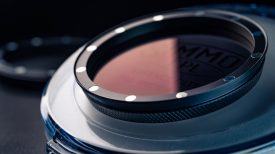Canon invited Newsshooter to see the new C700 FF at the Canon Burbank facility. All the major competitors now offering top-tier full-frame digital cinema cameras (except Panasonic). Sony has the VENICE, ARRI has the ALEXA LF and ALEXA 65, RED has the MONSTRO 8K VV and new entrant Kinefinity has announced the MAVO LF which will be shown at Cinegear. With the announcement of the C700 FF, Canon has finally joined the party.
The C700 FF looks very similar to its 4K sibling but the sensor is all new. Unlike some of the competition, Canon will not have paid upgrades for the C700 FF. The camera will ship fully functional with all the included features. Let’s take a closer look at the new features.
It’s all about the full frame sensor
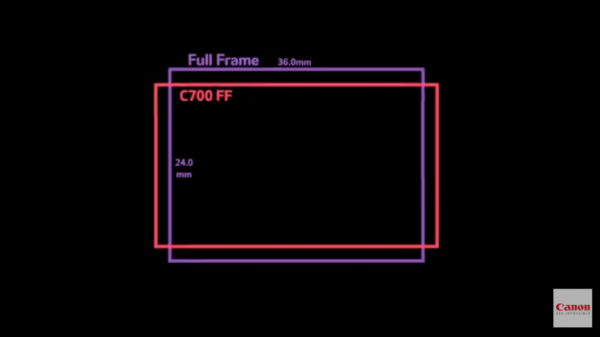
The sensor in the C700 FF is not the same as the full frame EOS 5D camera series (36.0mm x 24mm), it’s wider, but not as tall (38.1 x 20.1 mm). The C700 sensor is 17×9 and is 5.9K at 5952 x 3140. That’s 48 lines shy of a full 6K sensor. The sensor supports readout at full size, as well as Super 35mm, Super 16mm and anamorphic modes. In addition to full-frame lenses, it can be used with conventional Super 35mm lenses to originate 4K / UHD standardized production formats and Super 16mm lenses (with an adapter) to originate 2K / HD production formats in crop modes. The camera is equipped with three Digic 5 processors.
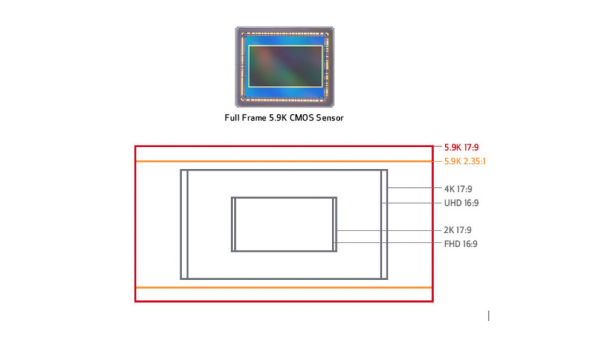
The actual sensor size is 38.1 x 20.1 mm with an image circle of 43.1 mm. This information is important to have when choosing full frame lens for coverage on the C700 FF. As a comparison the ARRI ALEXA LF Large Format Camera features a 36.7mm x 25.54mm sensor, the Sony VENICE uses a 36.2 x 24.1mm sensor, and the MONSTRO 8K VV sensor that can be found in the RED WEAPON and Panavision Millennium DXL2 is 40.96mm x 21.60mm.
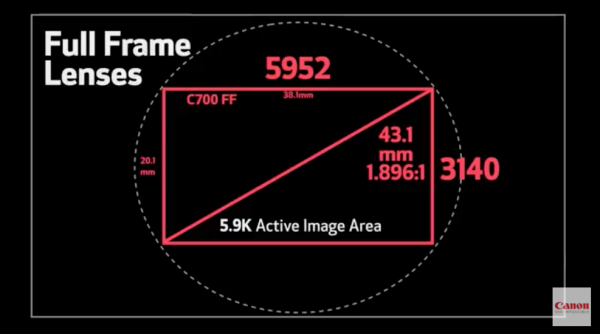
With an image circle of 43.1mm, the C700 FF it is very similar to the Sony VENICE (43.14mm) and slightly smaller than the ARRI Alexa LFs 44.71mm Open Gate.
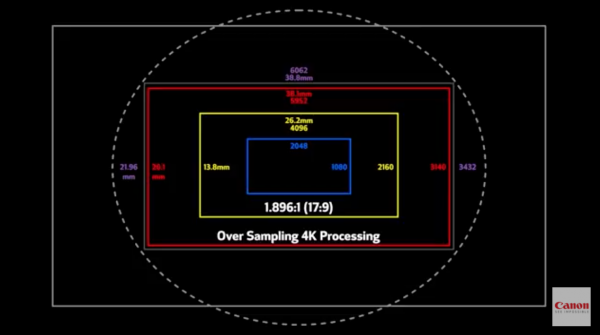
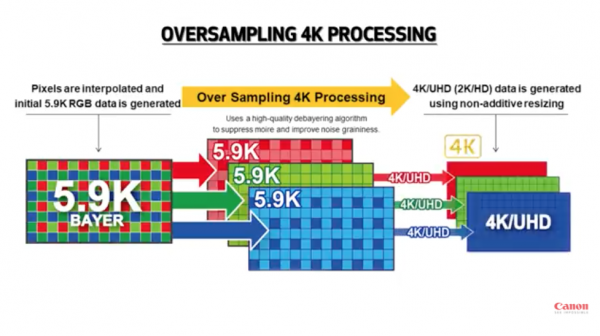
The C700 FF uses an oversampling process from the 5.9K image capture to produce 4K (DCI or UHD). Canon claims that this enhances image sharpness, curtailed moire, and produces a lowered visibility of noise at the higher ISO settings. Canon states the image will be sharper with better detail and will resolve colour better than the original C700 when shooting in 4K, UHD, 2K and HD. Just to be clear, anytime you select the full frame shooting mode on the C700FF and you are recording XF-AVC or ProRes, you are oversampling the 5.9K sensor.
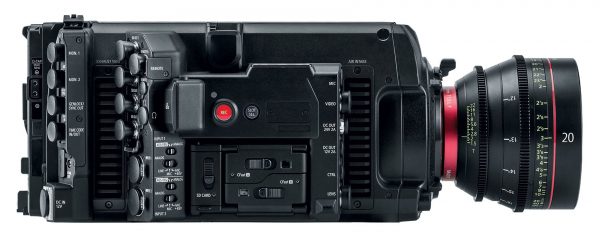
The C700 FF is basically identical to the C700. Side by side you won’t see a difference but what’s behind the lens mount is a 17×9 aspect ratio 5.9K sensor. The benefit of the larger 17 x 9 sensor is the ability to frame 4K DCI. The C700 FF has anamorphic support just like the original C700. The camera will de-squeeze the image to make viewing on monitors as well as the viewfinder much easier.
Another advantage of the larger sensor is that when shooting in 6K anamorphic mode, the camera will retain a 4K image. This is important if the camera is going to be used for a Netflix or other networks requiring 4K delivery. If you shoot 4K anamorphic after pulling it out it will closer to 3K and if you need to be 4K compliant you will be out of luck.
When recording internally in either Xf-AVC or ProRes, the camera can record 4K DCI, UHD, 2K or HD at frame rates up to 29.97pp regardless of whether the camera is in the full frame or Super35 modes.
Dual Pixel CMOS AF
The EOS C700 FF Digital Cinema Camera features next generation Dual Pixel CMOS AF (DAF) Technology. Each pixel in the camera’s CMOS sensor is configured with two photodiodes.
Two independent image signals can then be detected at each photosite. By implementing phase-difference AF, smooth focusing is accomplished using Canon EF lenses with much higher speed and accuracy than was possible with previous technologies.
The EOS C700 FF has rapid one-touch AF (with a push-button) and continuous AF within approximately 80% of the overall image area. Face detection AF is another autofocus mode that can track a person’s face in the frame and maintain focus on them. To further fine tune AF performance, the EOS C700 FF offers the ability to set the AF tracking speed and response.
DAF also makes possible the Dual Pixel Focus Guide. Dual Pixel Focus Guide presents the user with a rectangle in the center of the EVF or monitor. The rectangle turns green when the subject is in focus. If the subject is out of focus the box will turn gray and the arrows will indicate which way to adjust the lens to regain focus.
A focus pre-set feature allows separate predetermined focus points to be selected, and when the SET button is pushed, the lens will move focus from one mark to the other.
Can I upgrade my C700 to get the C700 FF sensor?
If you own the original C700, you can upgrade to the full frame sensor at a later date. Pricing hasn’t been announced, but I would imagine it won’t be cheap. The sensor is not user upgradeable, and you will have to send your camera to an authorised Canon service centre to have it done. When Canon announced the C700 back in 2016, they made a point of saying the sensor block would be factory-upgradable and they have stuck to that promise. If you are a C700 owner then you will breath a little sigh of relief that the investment that you made (investment is probably the wrong word to use for a camera!) will still remain relevant for some time to come.
Codecs
The C700 FF has the same codecs as the original C700.
- XF-AVC/ MPEG-4 AVC/H.264
- ProRes/ Apple ProRes Codec
- RAW / Uncompressed
ProRes Resolution/Sampling
- ProRes4444XQ
- ProRes4444
- ProRes422HQ
- ProRes422
2048×1080 YCC422 10bit/1920×1080 YCC422 10bit
2048×1080 RGB444 12bit/1920×1080 RGB444 12bit
4096×2160 YCC422 10 bit/3840×2160 YCC422 10 bit
2048×1080 YCC422 10 bit/1920×1080 YCC422 10 bit
2048×1080 RGB444 12 bit/1920×1080 RGB444 12 bit
2048×1080 RGB444 10 bit/1920×1080 RGB444 10 bit
2048×1080 YCC420 8 bit/1920×1080 YCC420 8 bit
XF-AVC Bit Rate
810/440/410/310/225/210/170/160/90 Mbps Intra-frame
50 Mbps Long GOP
Raw
12/10 bit
5952×3140
5952×2532
4096×2160 (cropped)
2048×1080 (cropped)
Codex Raw recorder
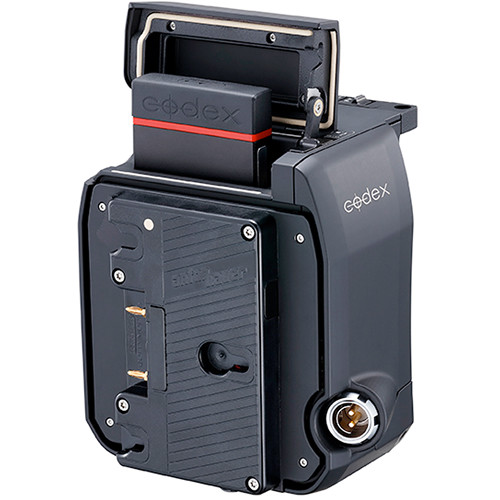
The C700 FF can record 5.9K up to 60p (10-bit Raw) and up to 30p (12-bit Raw) in the full frame mode, however, the Codex recorder will be required. If you shoot in the Super 35mm mode you can record 4K DCI (12-bit Raw) up to 72fps to the Codex recorder. If you drop the resolution down to 2K when in the Super 35mm mode you can record up to 168fps in 12-bit Raw.
The camera supports DPX and Raw signal output to an external recorder, however, the Raw recording will only be available with the Codex. Support for Raw debayering is needed from the manufactures if they choose to support the camera to record in ProRes or other codecs. At this time no external recorders other than the Codex are supported. The CDX-36150 Codex ($7,000 US) mounts easily to the camera with only a couple screws and all operation options are controlled with the C700 menu system. No buttons or menus are on the CDX-36150 Codex recorder.
The Codex is controlled directly through the cameras menu system. The rear of the Codex recorder has a battery plate with onboard Gold Mount battery connector. External power (10-32 VDC) can also be supplied to the 2-pin connector on the recorder body.
The Codex Recorder allows recording not only 5.9K RAW, but also ProRes at significantly higher frame rates than internal CFast Cards. When recording, RAW files are saved as a .RMF frame sequence in an uncompressed format with no baked in settings. Clip development can then be easily adjusted in post using the downloadable Canon Raw Development (CRD) software.
The CDX-36150 uses one Codex Capture Drive 2.0 (1 TB or 2 TB capacity), a familiar and commonly available professional recording media.
With a new firmware update, HDR support for viewing through the EVF as well as outputting to an external monitor will be available. ACES is also supported.
High frame rates available
This can be a little confusing to understand by just looking at the specifications, so I’ll try to make sense of it all for you. The original S35 C700 has a maximum frame rate of 240 fps internally in HD and 2K (crop mode), and up to 60fps in 4K DCI without a crop. Conversely the new C700 FF full-frame is only capable of 1- 168 fps in 2K or FHD internally (in the S16mm mode) when recording XF-AVC intra422 to Cfast. Internal ProRes 422 10-bit recording can be done in both the full frame and S35 modes in 4K/UHD at up to 30fps. In 2K/FHD you can record ProRes 4444 12-bit at up to 60 fps. The cameras high frame rates are not very impressive. I can’t see many people wanting to shoot in the S16MM crop mode just to get 168fps.
ProRes to CFast Full Frame / Super 35mm (cropped) up to 30P
ProRes 422 HQ
4096×2160 YCC 422 10-bit
3840×2160 YCC 422 10-bit
ProRes 4444 up to 60fps
2K 2048×1080
FHD 1920×1080
ProRes 422 HQ up to 60fps
2K 2048×1080
FHD 1920×1080
ProRes 422 HQ/ProRes 422 Super16 (Cropped) up to 168fps
2048×1080
1920×1080
XF-AVC internal to CFast Cards
4096×2160 422 10-bit to 60 fps
3840×2160 422 10-bit to 60 fps
2048×1080 422 10-bit to 60 fps
1920×1080 422 10-bit to 60 fps
2048×1080 10-bit & 12-bit to 60 fps
1920×1080 444 10-bit & 12-bit to 60 fps
The limitations are due to processing with the larger sensor. High frame rate recording up to 168 fps is possible at 2K/FHD but only in the S16MM crop mode. If you use the optional Codex CDX-36150 recorder docked onto the back of the EOS C700 FF you can record 5.9K 60 fps RAW, 4K RAW up to 72 fps (in 24p mode), 2K Raw up to 168fps. The C700 FF can also record externally to the Codex in ProRes 4444XQ 12-bit in 4K DCI, UHD, 2K or HD up to 60 fps. If you drop to ProRes 422HQ the Codex can record 4K, UHD, 2K and HD at up to 72fps. This is all possible regardless of whether the camera is in the full frame or Super 35mm mode. If you set the C700 FF in the S16MM mode you can record ProRes 422 HQ at up to 168fps to the Codex. Additional formats are planned with future firmware updates.
Lens Mount
As with the original C700, the full frame model has a locking EF mount or PL mount option. A B4 mount is also available. The B4 mount has an optical correction lens inside to correct the image circle as well as reducing chromatic aberrations. The C700 FF also has software to assist in chromatic aberration and overall image quality when using the B4 mount. Cooke i Technolgy is also supported
The lens mount is swappable, however, it will void the warranty if done by the user. Canon service can perform this for the user for $500 plus the cost of the mount. Canon is looking into making the mount easier for users to change without voiding the warranty at a later date.
New support kit
Canon also decided to develop a line of support kits such as EVF, mic holders, and shoulder mounts to customize the C700 for handheld or live ENG situations. Pricing and availability haven’t been announced.
Frame Rates
59.94 Hz,
24.00 Hz
59.94 Hz mode: 59.94i/59.94P/29.97P/23.98P
24.00 Hz mode: 24.00P
New internal ND Filters
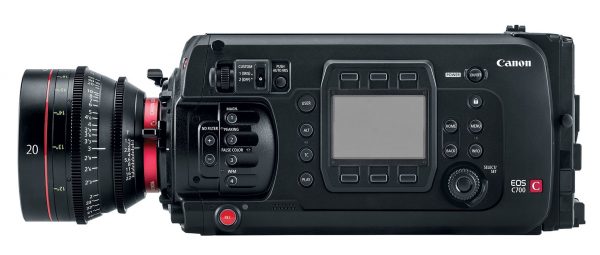
With a larger sensor, the internal ND system had to be redesigned. Replacing the existing turret design with individual stacking slots, similar to what is found on the lowlight ME20 camera. The C700 FF has a clear filter plus 2, 4 and 6 stops of ND. To increase further the 2 and 4 stop NDs will stack to get 6 stops and the 2 and 6 will stack to do 8. For 10 stops the 6 and 4 are stacked together.
The Cinema EOS Line-Up
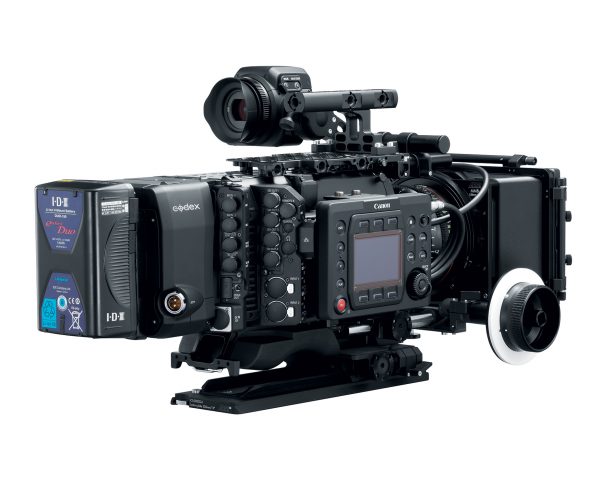
Canon is in a good position for full frame cinema with the extensive line-up of full frame cinema lenses available. The new full-frame sensor has DPAF that has 80% sensor coverage and can take full advantage of the Canon Compact Zoom lenses or any Canon EF lens that has AF on board. Canon see’s the Cinema EOS line-up being in a good place right now with the XC-15, C200, C300 MKII right behind for situations where smaller lighter cameras are needed for modern filmmaking.
Canon will showcase a demo film produced with the C700 FF shot in 6K anamorphic and mastered in 4K at NAB 2018. The C700 FF will be priced at $33,000 US ($5,000 more than the C700), it will be available in EF or PL mount. It is scheduled to start shipping sometime in July 2018. This price point is considerably lower than the Sony VENICE at $42,000 US and the ALEXA LF at $98,200 US. It is important to note that you will need to spend an additional $7000 US plus the cost of media to record anything in 6K, which would put it at almost the same price of the Sony VENICE.
Canon is again playing catch up with the C700 FF and it faces very stiff competition from its rivals. With the camera not being available until July, its competition already has a big head start. As we have seen in the past, often if you are late to the party you walk away with no cake. Let’s hope this isn’t the case for the C700 FF.
Would you buy a C700 FF? What do you think about Canon’s latest offering? Let us know in the comments section below.
Full Specifications
Sensor
CMOS Sensor with DAF Technology
Image Processing Platform
Triple DIGIC DV 5
Total Pixels
Approx. 20.8 megapixels (6062 x 3432)
Number of Effective Pixels
Approx. 18.69 megapixels (5952 x 3140):
When 4096 x 2160 or 2048 x 1080 is selected as the resolution
Approx. 17.52 megapixels (5580 x 3140):
When 3840 x 2160 or 1920 x 1080 is selected as the resolution
RAW Recording Pixels 5952 x 3140
Lens Mount
EF mount (cinema lock type) or PL mount
Exposure Modes
(1) Manual exposure based on shutter setting, iris setting, ISO/gain setting and ND filter setting
(2) Push auto iris control, auto iris control
(Light metering system selection/AE shift possible)
Shutter Setting
Speed, Angle, Clear Scan, Slow or Off mode selected Either 1/3 or 1/4 steps selected as speed increment
Iris Setting
Can be set to 1/2-stop, 1/3-stop or Fine
(1) Push auto iris control
(2) Auto iris control
Lenses that support Auto Iris
EF Lenses
EF-S 10–18mm f/4.5–5.6 IS STM EF-S 18–55mm f/3.5–5.6 IS STM EF-S 18–135mm f/3.5–5.6 IS STM EF-S 55–250mm f/4–5.6 IS STM EF 24–105mm f/3.5–5.6 IS STM EF-S 18–135mm f/3.5–5.6 IS USM EF-S 18–55mm f/4–5.6 IS STM EF 70–300mm f/4–5.6 IS II USM EF-S 35mm f/2.8 Macro IS STM EF 85mm f/1.4L IS USM
CINE-SERVO Lenses
CN7x17 KAS S/E1
CN7x17 KAS S/P1
CN20x50 IAS H/E1
CN20x50 IAS H/P1
CN-E 18–80mm T4.4 L IS KAS S CN-E 70–200mm T4.4L IS KAS S1
Cinema Prime Lenses
CN-E 14mm T3.1 L F CN-E 20mm T1.5 L F CN-E 24mm T1.5 L F CN-E 35mm T1.5 L F CN-E 50mm T1.3 L F CN-E 85mm T1.3 L F CN-E 135mm T2.2 L F
ENG Broadcast Lenses (2/3 mount lenses which allow for 12-pin communication using B4 mount) HJ14ex4.3B IASE S
HJ18ex7.6B IASE S
HJ24ex7.5B IASE S
HJ17ex7.6B IASE S
HJ22ex7.6B IASE S
(The optional MO-4E or MO-4P B4 Adapter is required.)
ISO
1 step, 1/3 step settings
[100* – 160 – 25600 – 102400*] * When the sensitivity is expanded
ND Filter
5 density settings (2, 4, 6, 8*, 10* stops)
* When expansion is selected
Focus Control
Dual Pixel CMOS AF supported
Manual Focus, One-Shot AF, Continuous AF, AF-Boosted MF, Face Detection AF Only lenses that support AF functions can be used in any of these modes.
Focus Guide
Display available focus status or unfocused status using the AF signal. It is useful while MF or One-Shot AF is not being performed. When the AF frame is set to movable, the guide display can be moved to any position by operating the joystick. If the AF frame is xed to the center of the display, the guide can be moved independently of the xed AF frame. The guide can be displayed in the main frame or sub frame. When displaying, the main and sub frames will be swapped with every SET operation.
Controls Display
3.0-inch (7.66cm on the diagonal) color liquid crystal Approx. 1.036 million dots
Viewfinder
None (OLED Electronic View nder EVF-V70: Sold separately)
White Balance
AWB, User Setting (setting range: 2000 K to 15000 K/-20 CC to +20 CC), Daylight, Tungsten, Set (A/B)
System Frequency Selection
59.94 Hz, 24.00 Hz
59.94 Hz mode: 59.94i/59.94P/29.97P/23.98P 24.00 Hz mode: 24.00P
Recording Media
CFast Card (2 slots)
Movies (XF-AVC/ProRes), custom pictures, metadata recording
SD Card
Movies (XF-AVC (proxy)), photos (JPEG), custom pictures, metadata, menus and other data
Codex Capture Drive
Movies (ProRes / RAW)
Compression Formats
(1) XF-AVC/MPEG-4 AVC/H.264
(2) ProRes/Apple ProRes Codec
(3) RAW
Resolution / Sampling
XF-AVC
Resolution / Sampling
4096×2160 YCC422 10 bit/3840×2160 YCC422 10 bit 2048×1080 YCC422 10 bit/1920×1080 YCC422 10 bit 2048×1080 RGB444 12 bit/1920×1080 RGB444 12 bit 2048×1080 RGB444 10 bit/1920×1080 RGB444 10 bit
Bit Rate
810/440/410/310/225/210/170/160/90 Mbps Intra-frame 50 Mbps Long GOP
ProRes
Resolution / Sampling
4096×2160 YCC422 10 bit/3840×2160 YCC422 10 bit 2048×1080 YCC422 10 bit/1920×1080 YCC422 10 bit 2048×1080 RGB444 12 bit/1920×1080 RGB444 12 bit
Bit Rate
ProRes4444XQ /ProRes4444/ProRes422HQ /ProRes422
XF-AVC (Proxy)
Resolution / Sampling
2048×1080 YCC420 8 bit/1920×1080 YCC420 8 bit
Bit Rate
24/35 Mbps Long GOP
RAW
Bit Depth
12/10 bit
Resolution
5952×3140 5952×2532 4096×2160 (cropped) 2048×1080 (cropped)
Gamma
Canon Log 3/Canon Log 2/Canon Log/Wide DR etc.
Color Space
Cinema Gamut/BT.2020 Gamut/DCI-P3 Gamut/BT.709 Gamut
LUT
BT.709/BT.2020/DCI/ACESproxy/HDR-ST2084 etc.
Others
Slow & Fast motion recording (max. 168 fps supported), relay recording, double slot recording, custom picture settings, color bar, peaking display, zebra display, My Menu settings, waveform monitor display, custom function, assignable buttons, key lock, marker displays, enlarged display, custom display, Control via Browser Remote, peripheral illumination correction, monaural microphone, fan control, correction of chromatic aberration of magni cation, geotagging and other functions
Input
GENLOCK terminal (also serves as SYNC OUT terminal), TIME CODE terminal (input/output switching), REMOTE terminals (A/B), MIC jack, INPUT terminal (XLR: 2 sets)
Output
MON. (1/2) terminals, SDI-OUT terminal (1–4), HDMI OUT terminal, headphones jack, SYNC OUT terminal (also serves as GENLOCK terminal), TIME CODE terminal (input/output switching), VIDEO terminal
Dimensions (W x H x D)
Approx. 6.6 x 6.1 x 12.9 in. (167 x 154 x 327mm)
Weight
Approx. 7.6 lb. (3455g)

